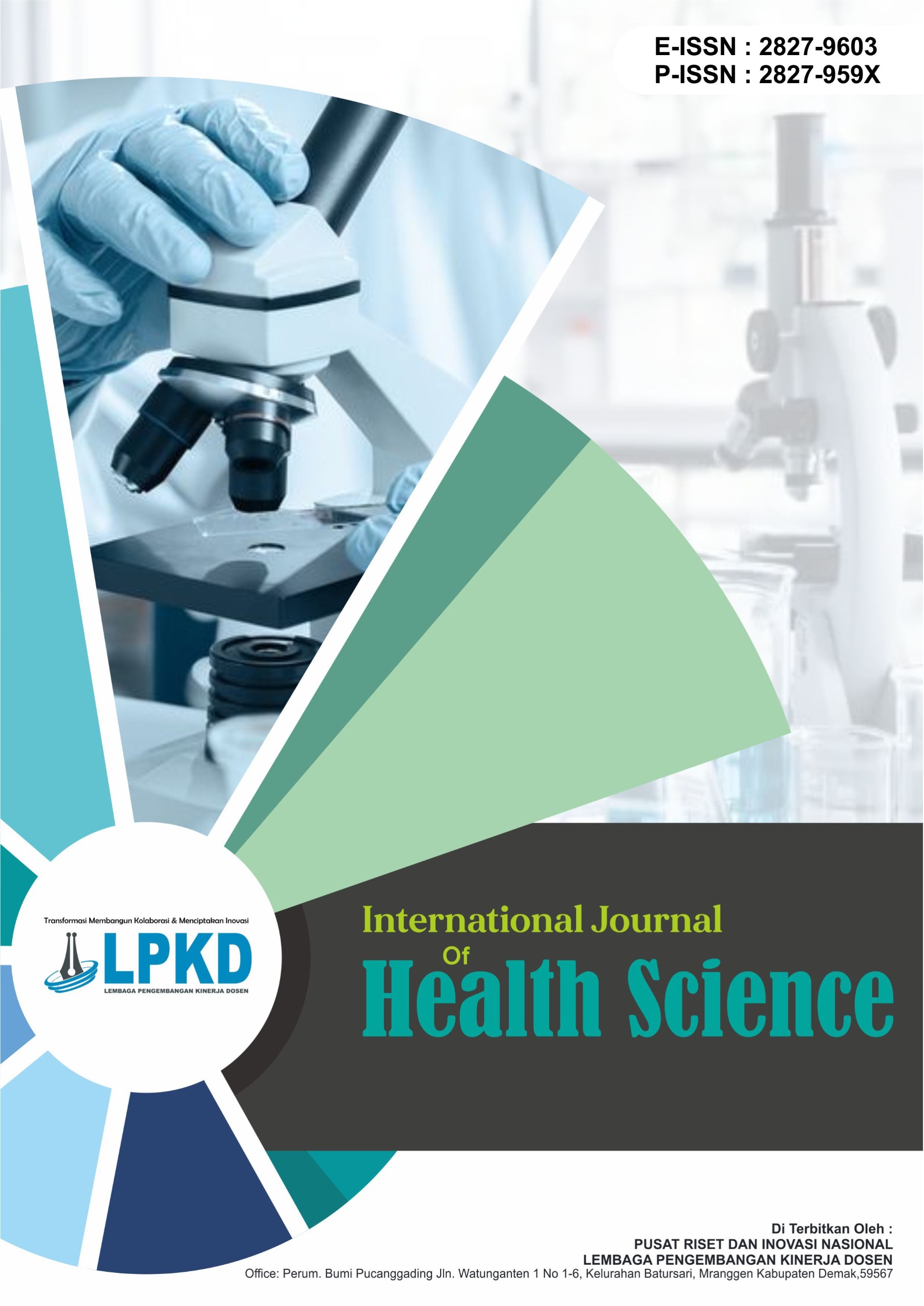The Potential of Bajakah Endophytic Fungus (Spatholobus littoralis Hassk) Against Staphylococcus aureus Bacteria
DOI:
https://doi.org/10.55606/ijhs.v5i3.6230Keywords:
Bacteria, Bajakah, Endophytic Fungi, Plant, Staphylococcus AureusAbstract
A plant that has great potential as a source of traditional medicine is Spatholobus littoralis Hassk, or better known as bajakah. The research aims to analyze the Potential of Bajakah Endophytic Fungi (Spatholobus littoralis Hassk) Against Staphylococcus aureus Bacteria. This research was conducted at the Pharmaceutical Microbiology Laboratory, Faculty of Health, Sari Mulia University, Banjarmasin. The study used endophytic fungi on Bajakah wood (Spatholobus littoralis Hassk). The research design used was a True Experimental design with the aim of identifying the antibacterial activity of Bajakah endophytic fungi (Spatholobus littoralis Hassk) and testing the inhibitory power of Bajakah endophytic fungi (Spatholobus littoralis Hassk) against Staphylococcus aureus bacteria. Three isolates of endophytic fungi from Bajakah stems (Spatholobus littoralis Hassk) showed antibacterial activity against Staphylococcus aureus bacteria with varying levels of potency. Isolate (JEB 1) which is estimated to originate from Aspergillus sp showed very strong antibacterial activity with an inhibition zone diameter of 27.18 ± 0.725 mm. Isolate (JEB 1) has a Minimum Inhibitory Concentration (MIC) value at a concentration of 5 x 106 ppm and the best Minimum Bactericidal Concentration (MBC) at a concentration of 5 x 106 ppm. These findings indicate that endophytic fungi, especially from Aspergillus sp, have potential as natural antibacterial agents that can be further developed as candidates for new antibacterial materials based on local natural resources.
Downloads
References
Abdulrahman, Utami, S. R., Widia, & Roanisca, O. (2022). Study of secondary metabolites of Bajakah stems (Spatholobus littoralis Hassk.) in development as an anti-breast cancer and antioxidant herbal medicine. Cendekia Journal of Pharmacy, 6(1), 1–12. https://journal.farmasi.ac.id/cendekia/article/view/178
Amin, N. F., Garancang, S., & Abunawas, K. (2023). General concepts of population and sample in research. Pilar, 14(1), 15–31. https://journal.universitaspahlawan.ac.id/index.php/pilar/article/view/17897
Fitriana, Y. A. N., Fatimah, V. A. N., & Fitri, A. S. (2020). Antibacterial activity of betel leaves: Minimum inhibitory concentration (KHM) and minimum bactericidal concentration (KBM) extract test. Sainteks, 16(2), 101–108. https://ejournal.upbatam.ac.id/index.php/saintek/article/view/2818
https://doi.org/10.30595/sainteks.v16i2.7126
Hartini, S., Sari, P. R., & Wulandari, I. (2021). Potential of endophytic fungi as natural antibacterials. Journal of Tropical Biotechnology, 9(2), 71–77. http://ejournal.unmuhjember.ac.id/index.php/JBT/article/view/4234
Hendrawan, H., Lestari, N. D., & Wahyuni, S. (2022). MIC and MBC assay of endophytic fungi from tropical forest plants against gram-positive bacteria. Indonesian Journal of Phytopharmaca, 9(2), 98–104. https://journal.unhas.ac.id/index.php/jifi/article/view/22383
Indrawati, A., Hartih, N. A., & Muyassara. (2019). Isolation and potential testing of endophytic fungi from langsat (Lansium domesticum Corr.) stem bark to produce antibacterials against Staphylococcus aureus and Escherichia coli. Media Pharmacy – Poltekkes Makassar, 15(1). https://doi.org/10.32382/mf.v15i1.776
Iskandar, D., Masruri, M., Widodo, N., Rollando, R., & Warsito, W. (2022). Phenolic content, antioxidant, cytotoxicity of fractions of Spatholobus littoralis Hassk from Kalimantan, Indonesia. Journal of Hunan University Natural Sciences. https://doi.org/10.55463/issn.1674-2974.49.3.2
Ismail, N., Ramadhan, D., & Widyaningrum, A. (2018). Identification of endophytic fungal morphology and antibacterial potential. Journal of Tropical Biology, 18(3), 245–251.
Jaber, L. R., & Enkerli, J. (2017). Fungal endophytes: Beyond herbivore management. Journal of Applied Microbiology, 123(6), 1414–1425.
Kementerian Kesehatan Republik Indonesia. (2020). Profil Kesehatan Indonesia 2020. Ministry of Health.
Kurnianto, M., Pangkahila, W., & Susraini. (2020). Administration of Bajakah (Spatholobus littoralis Hassk.) stem ethanol extract increased the number of Leydig cells and testosterone levels in male Wistar rats (Rattus norvegicus) with excessive swimming activity. International Journal of Science and Research, 9(12), 1–5. https://www.ijsr.net/archive/v9i12/ART20203588.pdf
Latu, S., Suleman, A. W., & Mansur. (2023). Antibacterial activity test of Bajakah wood (Spatholobus littoralis Hassk.) against the growth of Staphylococcus aureus. Journal of Pharmaceutical Sciences, 4(1), 108–114. https://ejournal.poltekkes-mks.ac.id/index.php/JIF/article/view/1004
Mahdiyah, D., Farida, H., Riwanto, I., Mustofa, M., Wahjono, H., Laksana Nugroho, T., & Reki, W. (2020). Screening of Indonesian peat soil bacteria producing antimicrobial compounds. Saudi Journal of Biological Sciences, 27(10), 2604–2611. https://doi.org/10.1016/j.sjbs.2020.05.033
Manurung, B., Nurjanah, S., & Syahputra, D. (2022). Exploration of endophytic fungi from tropical forest plants and their potential in secondary metabolite production. Indonesian Journal of Microbiology, 20(1), 34–41. http://journal.ipb.ac.id/index.php/jmi/article/view/35472
Maulidya, R. F., Suryadi, Y., & Putri, A. P. (2023). Analysis of inhibition zones of endophytic fungal isolates against S. aureus. Indonesian Journal of Microbiological Sciences, 5(1), 21–28. https://jsmi.farmasi.unhas.ac.id/index.php/jsmi/article/view/118
Mochtar, C. F., Saleh, L. O., Hamzah, H., & Ilyas, N. M. (2022). Potential of Bajakah Tampala (Spatholobus littoralis Hassk.) as an antibacterial and antifungal agent against Staphylococcus aureus and Candida albicans. Jurnal Mandala Pharmacon Indonesia, 8(2), 177–184. https://doi.org/10.35311/jmpi.v8i2.212
Monika, P., Santoso, A., & Hidayat, A. (2020). Endophytic fungi as a source of bioactive compounds: A review of their potential and applications. Indonesian Journal of Biotechnology and Bioscience, 7(2), 85–94. https://ejurnal.lipi.go.id/index.php/JBBI/article/view/1296
Nastiti, K., & Nugraha, D. F. (2022). Anti-inflammatory activity of Bajakah wood extract (Spatholobus littoralis Hassk.). Surya Medika Journal, 7(2), 45–50. https://doi.org/10.33084/jsm.v7i2.3202
Nurjanah, L., Rini, D. F., & Anisa, R. (2023). Potential of secondary metabolites of endophytic fungi against S. aureus: MIC and MBC studies. Journal of Pharmaceutical Microbiology, 7(1), 12–19.
Oktavira, I., Nastiti, K., Hakim, A. R., & Rohama, R. (2024). Potential of Bajakah stem endophytic fungi (Spatholobus littoralis Hassk) as antibacterials against Escherichia coli. International Conference on Health and Science, 2(1), 26–37.
Pratiwi, S. D., Kurniawan, H., & Salimah, S. (2022). The effect of secondary metabolites of endophytic fungi on gram-positive bacteria. Indonesian Journal of Applied Microbiology, 4(3), 98–105. https://journal.unesa.ac.id/index.php/ijam/article/view/25368
Rahayu, D., Yuliani, T., & Handayani, S. (2023). Antibacterial effect of endophytic fungal extracts from tropical forest plant bark. Journal of Applied Microbiology, 10(2), 44–52.
Rohmania, A. (2021). Antibacterial activity test of ethanol fraction of Bajakah Tampala (Spatholobus littoralis Hassk.) stems against Bacillus subtilis and Escherichia coli. Jurnal Biologi Indonesia, 6. https://ejournal.biologi.lipi.go.id/index.php/jbi/article/view/727
Sari, M. P., Wijaya, A. K., Hidayatullah, B., Sirodj, R. A., & Afgani, M. W. (2023). Ethnographic applications in social research. Journal of Peins and Computers, 3(1), 84–90. https://doi.org/10.47709/jpsk.v3i01.1956
Syamsudin, A., Putri, M. F., & Kurniawan, A. (2021). Study of MIC and MBC of endophytic fungal isolates from Kalimantan herbal plants. Journal of Tropical Biology, 8(1), 53–60.
Wathan, N., Maningsih, W., & Rizki, M. (2021). Isolation and antibacterial screening of endophytic fungi from Bajakah plants (Spatholobus littoralis Hassk.). Indonesian Journal of Biology, 17(2), 123–130. https://ejournal.biologi.lipi.go.id/index.php/jbi/article/view/727
Downloads
Published
How to Cite
Issue
Section
License
Copyright (c) 2025 International Journal Of Health Science

This work is licensed under a Creative Commons Attribution-ShareAlike 4.0 International License.







